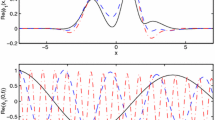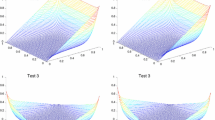Abstract
The thermal radiative transfer (TRT) equations form an integro-differential system that describes the propagation and collisional interactions of photons. Computing numerical solutions of the TRT equations accurately and efficiently is challenging for several reasons, the first of which is that TRT is defined on a high-dimensional phase space that includes the independent variables of time, space, and velocity. In order to reduce the dimensionality of the phase space, classical approaches such as the P\(_N\) (spherical harmonics) or the S\(_N\) (discrete ordinates) ansatz are often used in the literature. In this work, we introduce a novel approach: the hybrid discrete (H\(^T_N\)) approximation to the radiative thermal transfer equations. This approach acquires desirable properties of both P\(_N\) and S\(_N\), and indeed reduces to each of these approximations in various limits: H\(^1_N\) \(\equiv \) P\(_N\) and H\(^T_0\) \(\equiv \) S\(_T\). We prove that H\(^T_N\) results in a system of hyperbolic partial differential equations for all \(T\ge 1\) and \(N\ge 0\). Another challenge in solving the TRT system is the inherent stiffness due to the large timescale separation between propagation and collisions, especially in the diffusive (i.e., highly collisional) regime. This stiffness challenge can be partially overcome via implicit time integration, although fully implicit methods may become computationally expensive due to the strong nonlinearity and system size. On the other hand, explicit time-stepping schemes that are not also asymptotic-preserving in the highly collisional limit require resolving the mean-free path between collisions, making such schemes prohibitively expensive. In this work we develop an asymptotic-preserving numerical method that is based on a nodal discontinuous Galerkin discretization in space, coupled with a semi-implicit discretization in time. In particular, we make use of a second order explicit Runge–Kutta scheme for the streaming term and an implicit Euler scheme for the material coupling term. Furthermore, in order to solve the material energy equation implicitly after each predictor and corrector step, we linearize the temperature term using a Taylor expansion; this avoids the need for an iterative procedure, and therefore improves efficiency. In order to reduce unphysical oscillation, we apply a slope limiter after each time step. Finally, we conduct several numerical experiments to verify the accuracy, efficiency, and robustness of the H\(^T_N\) ansatz and the numerical discretizations.











Similar content being viewed by others
References
Adams, M.P., Adams, M.L., Hawkins, W.D., Smith, T., Rauchwerger, L., Amato, N.M., Bailey, T.S., Falgout, R.D., Kunen, A., Brown, P.: Provably optimal parallel transport sweeps on semi-structured grids. J. Comput. Phys. 407, 109–234 (2020)
Brunner, T.A., Holloway, J.P.: Two-dimensional time-dependent Riemann solvers for neutron transport. J. Comput. Phys. 210(1), 386–399 (2005)
Carlson, B.: Solution of the Transport Equation by the S$_N$ Method. Los Alamos National Laboratory, Santa Fe (1955)
Carlson, B.: Tables of Symmetric Equal Weight Quadrature EQN Over the Unit Sphere. Los Alamos National Laboratory, Santa Fe (1971)
Cohen, A.: An algebraic approach to certain differential eigenvalue problems. Linear Algebra Appl. 240, 183–198 (1996)
Dubroca, B., Feugeas, J.L.: Etude théorique et numérique d’une hiérarchie de modèles aux moments pour le transfert radiatif. Comptes Rendus de l’adémie des Sciences-Series I-Mathematics 329(10), 915–920 (1999)
Evans, T.M., Urbatsch, T.J., Lichtenstein, H., Morel, J.E.: A residual Monte Carlo method for discrete thermal radiative diffusion. J. Comput. Phys. 189(2), 539–556 (2003)
Fan, Y.W., Li, R., Zheng, L.C.: A nonlinear moment model for radiative transfer equation in slab geometry. J. Comput. Phys. 404, 109–128 (2020)
Fleck, J.A., Jr., Cummings, J.D.: An implicit Monte Carlo scheme for calculating time and frequency dependent nonlinear radiation transport. J. Comput. Phys. 8(3), 313–342 (1971)
Gustafsson, B., Kreiss, H.O., Oliger, J.: Time-Dependent Problems and Difference Methods, 2nd edn. Wiley, New York (2013)
Hauck, C., McClarren, R.: Positive p$_{\rm n}$ closures. SIAM J. Sci. Comput. 32(5), 2603–2626 (2010)
Hauck, C.D.: High-order entropy-based closures for linear transport in slab geometry. Commun. Math. Sci. 9(1), 187–205 (2011)
Hauck, C.D., McClarren, R.G.: Positive P$_N$ closures. SIAM J. Sci. Comput. 32(5), 2603–2626 (2010)
Jarrell, J., Adams, M.: Discrete-ordinates quadrature sets based on linear discontinuous finite elements. In: Proceedings of International Conference on Mathematics and Computational Methods Applied to Nuclear Science and Engineering, Rio de Janeiro, Brazil (2011)
Klar, A.: An asymptotic-induced scheme for nonstationary transport equations in the diffusive limit. SIAM J. Numer. Anal. 35(3), 1073–1094 (1998)
Klar, A., Unterreiter, A.: Uniform stability of a finite difference scheme for transport equations in diffusive regimes. SIAM J. Numer. Anal. 40(3), 891–913 (2002)
Koch, R., Krebs, W., Wittig, S., Viskanta, R.: The discrete ordinate quadrature schemes for multidimensional radiative transfer. J. Quant. Spectrosc. Radiat. Transf. 53(4), 353–372 (1995)
Laiu, M.P., Hauck, C.D., McClarren, R.G., O’Leary, D.P., Tits, A.L.: Positive filtered P$_N$ moment closures for linear kinetic equations. SIAM J. Numer. Anal. 54(6), 3214–3238 (2016)
Larsen, E., Pomraning, G., Badham, V.: Asymptotic analysis of radiative transfer equations. J. Quant. Spectrosc. Radiat. Transf. 29(4), 285–310 (1983)
Lathrop, K.D.: Ray effects in discrete ordinates equations. Nucl. Sci. Eng. 32(3), 357–369 (1968)
Lathrop, K.D.: Remedies for ray effects. Nucl. Sci. Eng. 45(3), 255–268 (1971)
Lathrop, K.D., Carlson, B.G.: Discrete ordinates angular quadrature of the neutron transport equation. Los Alamos Scientific Laboratory Report 3186 (1965)
Lau, C., Adams, M.: Discrete ordinates quadratures based on linear and quadratic discontinuous finite elements over spherical quadrilaterals. Nucl. Sci. Eng. 185(1), 36–52 (2017)
Lewis, E.E., Miller, W.F.: Computational Methods of Neutron Transport. Wiley, DeKalb (1994)
Li, W., Liu, C., Zhu, Y., Zhang, J., Xu, K.: Unified gas-kinetic wave-particle methods III: multiscale photon transport. J. Comput. Phys. 408, 109–280 (2020)
Lorenz, J., Schroll, H.J.: Stiff well-posedness for hyperbolic systems with large relaxation terms (linear constant-coefficient problems). Adv. Differ. Equ. 2(4), 643–666 (1997)
Lowrie, R.B.: A comparison of implicit time integration methods for nonlinear relaxation and diffusion. J. Comput. Phys. 196(2), 566–590 (2004)
McClarren, R.G., Evans, T.M., Lowrie, R.B., Densmore, J.D.: Semi-implicit time integration for P$_N$ thermal radiative transfer. J. Comput. Phys. 227(16), 7561–7586 (2008)
McClarren, R.G., Holloway, J.P., Brunner, T.A.: On solutions to the pn equations for thermal radiative transfer. J. Comput. Phys. 227(5), 2864–2885 (2008)
Mcclarren, R.G., Lowrie, R.B.: The effects of slope limiting on asymptotic-preserving numerical methods for hyperbolic conservation laws. J. Comput. Phys. 227(23), 9711–9726 (2008)
McClarren, R.G., Urbatsch, T.J.: A modified implicit Monte Carlo method for time-dependent radiative transfer with adaptive material coupling. J. Comput. Phys. 228(16), 5669–5686 (2009)
Olson, G.: Second-order time evolution of PN equations for radiation transport. J. Comput. Phys. 228(8), 3072–3083 (2009)
Olson, G.L., Auer, L.H., Hall, M.L.: Diffusion, p$_1$, and other approximate forms of radiation transport. J. Quant. Spectrosc. Radiat. Transf. 64(6), 619–634 (2000)
Parlett, B.N.: The Symmetric Eigenvalue Problem. Prentice-Hall Series in Computational Mathematics, vol. 61, No. 7, pp. 277–348 (1981)
Pomraning, G.C.: Variational boundary conditions for the spherical harmonics approximation to the neutron transport equation. Ann. Phys. 27, 193–215 (1964)
Pomraning, G.C.: The Equations of Radiation Hydrodynamics. Pergamon Press, Oxford (1973)
Shin, M.: Hybrid discrete (H$^T_N$) approximations to the equation of radiative transfer. Ph.D. thesis, Iowa State University, Ames (2019)
Siegel, R., Howell, J.R.: Thermal Radiation Heat Transfer, vol. 3. Hemisphere Publishing Corp., Washington (1972)
Su, B., Olson, G.L.: An analytical benchmark for non-equilibrium radiative transfer in an isotropically scattering medium. Ann. Nucl. Energy 24(13), 1035–1055 (1997)
Thurgood, C.P., Pollard, A., Becker, H.A.: The T$_N$ quadrature set for the discrete ordinates method. J. Heat Transf. 117(4), 1068–1070 (1995)
Vikas, V., Hauck, C., Wang, Z., Fox, R.: Radiation transport modeling using extended quadrature method of moments. J. Comput. Phys. 246(1), 221–241 (2013)
Wikipedia: Gaussian quadrature. https://en.wikipedia.org/wiki/Gaussian_quadrature (2021)
Wollaber, A.B.: Four decades of implicit Monte Carlo. J. Comput. Theor. Transp. 45(1–2), 1–70 (2016)
Zheng, W., McClarren, R.G.: Moment closures based on minimizing the residual of the PN angular expansion in radiation transport. J. Comput. Phys. 314, 682–699 (2016)
Acknowledgements
JAR was supported in part by NSF Grants DMS–1620128 and DMS–2012699.
Author information
Authors and Affiliations
Corresponding author
Additional information
Publisher's Note
Springer Nature remains neutral with regard to jurisdictional claims in published maps and institutional affiliations.
Rights and permissions
About this article
Cite this article
McClarren, R.G., Rossmanith, J.A. & Shin, M. Semi-implicit Hybrid Discrete \(\left( \text {H}^T_N\right) \) Approximation of Thermal Radiative Transfer. J Sci Comput 90, 2 (2022). https://doi.org/10.1007/s10915-021-01686-7
Received:
Revised:
Accepted:
Published:
DOI: https://doi.org/10.1007/s10915-021-01686-7
Keywords
- Thermal radiative transfer
- Discontinuous Galerkin
- Discrete hybrid approximation
- Semi-implicit time integration
- Asymptotic-preserving




